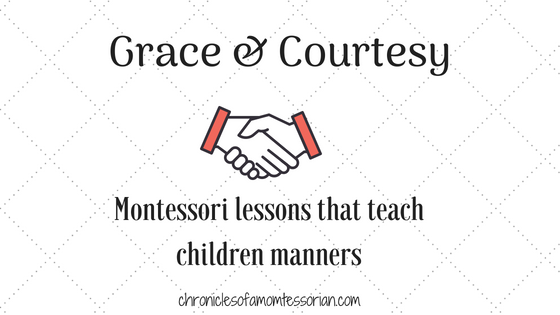Here it is…Part 3 of the Montessori Tidbits Series!!
The next post in the part series…talking about manners.
Here is the next installment of the new 4 part series, Montessori Tidbits: Ideas & Practices for newbies to the Montessori Method. Part 3 talks about a common Montessori practice; Grace & Courtesy. Grace & Courtesy is a method of teaching children manners in a variety of ways and situations, and once implemented by the children, can lead to a peaceful & respectful environment. If you’ve ever had the chance to be in a Montessori environment, met a Montessori child, or see Montessori children out in public, you may have noticed how well behaved, polite, courteous and self-disciplined they are. That is the magic of Grace & Courtesy.
Grace & Courtesy
Grace & Courtesy is a staple in a Montessori environment. It is as common as the 3 year age span, mixed aged groups. It is taught as young as 3 years of age, and is continued and revisited at the beginning of each school year. It is reintroduced at east once every year so that the teacher can demonstrate the expectations of each child. The main goal of grace & courtesy is to teach children proper manners. It provides them with ways to interact with other children and adults. Teachers and parents alike can easily introduce and teach grace & courtesy to a small or large group. The key is to provide instances where children can role play various social situations. Disrespect and rude behavior is rarely seen in a Montessori environment, as Grace & Courtesy is practiced and implemented on a regular basis.
This post may contain affiliate links. I may earn compensation when you click on the links; at no additional cost to you. Please see the disclosure policy for more information.
Objectives of implementing Grace & Courtesy
With proper implementation, Grace & Courtesy lessons can provide children with the tools to become kind, understanding, respectful individuals in our society. Here are a few ways Grace & Courtesy can be a positive addition to any home or classroom setting or environment.
Children learn how to respect others & the environment
With Grace & Courtesy lessons, adults can teach children the importance of respecting others belongings, their own belongings, and their environment; whether that be their home, bedroom, classroom or other places they visit.
Teacher/Adult: “Today we are going to talk about taking care of our things and the things of others.” When we use any of the materials, it is important to use gentle hands and be gentle using them.”
Teacher/Adult: “Would you like it if I came to your house and took your toys and threw them on the floor? Or if I broke your toys while playing with them?”
The children will all answer no, and you can conclude this lesson by explaining to them the importance of respecting the environment and the things within it.
Children develop skills that are used in many social situations
Lessons in Grace & Courtesy can give children the necessary skills needed in various social situations. Social situations with their peers, other adults, teachers, and any other people they will encounter. Knowing how to react and respond in social situations is a very important skill to develop early on.
Children are taught the importance of patience & understanding
Children learn how to be patient and wait for things. Grace & Courtesy lessons teach them that it is fine to have to wait for things, wait their turn for things, and to be understanding when situations don’t always go as they had plan. Things happen and it is our job as adults and role models to teach children to be understanding & accepting of things.
For example, it is customary in a Montessori environment for children to have snack at a designated “snack table”. The snack table is normally accommodating to two children at a time, so other children in the classroom must wait until an available spot at the snack table becomes available.
Grace & Courtesy Sample Lessons
These sample lessons are not an all inclusive list of Grace & Courtesy lessons that can be introduced to children. This list is of a few lessons that I have used in my classroom and find that they are the best at teaching children manners.
A suggestion on how to introduce Grace & Courtesy lessons are listed. Each sample lesson is easy to use and laid our in a way that any teacher or parent can introduce the lessons to one or a group of children. Each sample lesson can be used in a role play situation in which children can witness the real life experiences of each Grace & Courtesy lesson.
Sample 1: Waiting their turn to do a work or activity
Waiting for your turn is a way of life. There are times when children must wait for an activity or work. In a one on one or group setting, explain to the children that sometimes you may have to wait for a certain activity or work. Explain to them to choose another activity or work while they wait.
Teacher/Adult: “Sometimes a work or activity that you would to do is not available. Please be patient, and while you wait, choose another work or activity until the work you would like becomes available.”
Sample 2: Asking other children to join them in their activity
It is customary in a Montessori environment that children are not made to share. If they choose a work or activity, it is their choice to work independently or with a partner. In a one or one or group setting, inform the child(ren) that they must ask another child if it is ok if they can work with them.
Teacher/Adult: “If a friend has chosen a work, please remember that you must ask them first before you can work on an activity with them. If they say no, you must respect their words and find another work or activity,”
Sample 3: Interrupting an adult when they are having a conversation (The waiting Hand)
If an adult is having a conversation, children are shown how to wait patiently until the conversation ends. This can be demonstrated in a one on one situation or in a group setting.
Teacher/Adult: “If I am talking to someone, without saying anything, please put your hand on my leg or arm. I will place my hand over your hand so you know I will talk with you as soon as I am finished talking. Please remember to wait patiently.”
Sample 4: Respecting the personal space of other people
Children should learn to respect the personal space and boundaries of others. This can be done one on one or in a group setting. It works particularly good in a group setting.
Teacher/Adult: “Let’s pretend that everyone has a pretend invisible bubble around them. Try not to get too close to other peoples’ bubbles, because you may pop their bubble and invade their personal space.”
Effects of using Grace & Courtesy
These are Grace & Courtesy sample lessons and ideas that I have tried and tested. My hope is that they are of help to parents and other teachers. When taught and implemented, these lessons will (hopefully) lead to well mannered children who are polite, courteous and patient. These lessons should be revisited on a regular basis and the children should be reminded as needed, of these lessons.
Missed reading Part 1, Part 2 or Part 4 of the series? Click here for
Part 1: 10 Ideas to Achieve a Peaceful Home or Classroom Setting
Part 2: Positive Discipline The Montessori Way.
Part 4: The Montessori approach as to why children shouldn’t be forced to share
Part 5: 8 must haves for an awe-inspiring Montessori playroom
BONUS…
Grace & Courtesy Book Resources:
Montessori at Home or School: How to Teach Grace & Courtesy
Spring Tea: a celebration of grace and courtesy for children three to six
Have questions or thoughts on Grace & Courtesy in a Montessori environment? Feel free to reach out to me!
Anitra J.














I love doing these lessons in my classroom! We probably do them a little bit more often this year since we have a lot of energy in our room but our children seem to really enjoy it.
I particularly like our lesson where they serve each other water/snack. It gives the server a chance to be kind and share and the other child the opportunity to accept or decline politely.
Some of these lessons need to be revisited in my middle school classroom!
I love how you ask the children to place their hand on you when they are waiting to speak to you. I’ve never thought of doing this! Makes it much more concrete for them to understand.
These are important lessons to learn! Many adults would benefit from grace and courtesy lessons too!
I loved these tips
Thanks for the lessons
Such a key lesson for our kiddoes, I love the simplicity of this post!
I love this! Especially the grace & courtesy bit!
These lessons are so great! My son is ADHD, and he needs these lessons more frequently and deliberately. Great post!
We use pretty much all of these principles at home with our kids. Sometimes we change up the sharing thing in order to teach our son that he needs to gracious with his little brother and share things with him. But we don’t always enforce it and if it’s something he really wants or likes, we don’t force him to share.
Such great lessons to teach at a young age.
These are such important life lessons for children to learn. It’s good to teach them at the preschool age.
This was really great read. I love the ideas on implimenting the lessons too.
I always love learning more about the Montessori method. I’m going to try some of these tips with my kids.
I loved reading this post. My son has started a Montessori school recently and the more I read about this amazing method the more excited I am about it. I like the explanation about the personal bubble that can pop if we get too close to someone, thus invading their personal space. I will tell it to my little monkey as he tends to do it. Thank you for this great post.
You’re welcome Cristina! Yes, there are certain principles and ideas that you will only find in a Montessori evnironment!
Such important skills that really do need to be explicitly taught. Glad to see this is happening in some PS classrooms!
Oh wow I had no idea that grace and courtesy (or anything like it) were a part of the Montessori philosophy. I LOVE that! It’s so nice to know teachers/parents are focusing on teaching manners and propriety in Montessori since it’s so popular, and since we seem to desperately need to teach it in this world! I plan to incorporate these principles in my homeschooling.
There are some amazing tips here! Having courteous children is so important, and the earlier you can teach them, the better!
Grace and courtesy are so important to be introduced early. I like the fact that in Montessori we learn to respect both the adults as well as the kids perspective. Very well explained, I loved the examples that you have quoted especially the bubble one ,I could have never thought that.
These are excellent ways to help teach children grace and courtesy. Thank you for sharing!
I found this extremely helpful!
I love these tips! It’s so important for children to be learning stuff like this at a young age.
I love these. It’s so important for littles to know and practice these!
Such a great article – I love the advice on what to do when a child interrupts when an adult is talking. I am going to start doing that with my daughters!
Teaching kids about manners is such an important task because it helps build and mold them for the future.
these are good tips to share and practice
Wonderful! I love anything to do with social-emotional growth and development!